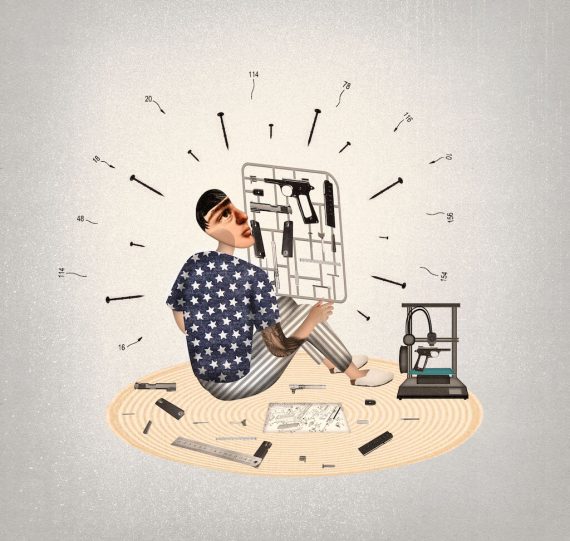Weapons produced via three-dimensional (3D) printing technology first appeared in the United States in 2013. Since then, they remained a serious threat which was constantly ignored. These are real weapons, easy to use, and cheap to produce, and pose an uncharted threat. This paper serves to warn individuals and states of the serious threat posed by 3D-printed weapons if no action is taken against these dangerous 3D “toys.”
3D printing technology
To understand how 3D-printed weapons work, we need to understand 3D printing technology, which has been developing since the 1980s. 3D printing is the process of converting models designed by a computer device into solid forms. Unlike the traditional model of production, 3D printing technology creates very little waste material and provides high efficiency, and for this reason it is in high demand in recent years.
The raw material of production in 3D printing technology includes colored and hard thermoplastic or metal rolls known as “filaments” that are used instead of the cartridges in 2D printers that we use in our daily life. These filaments are usually obtained by the industrial processing of materials such as resins, polymers, or composites. Devices that perform 3D printing and reveal products are known as 3D printers.
The most important feature that distinguishes these devices from the printers used in daily life is that they can move along the vertical axis as well as the horizontal and right-left axes. With 3D printers technically based on a three-axis Computer Numerical Control (CNC) mechanism, many different products can be printed, from clocks to pens, sculptures to weapon parts, and shoes to car parts.
Accordingly, it appears that two basic parts are required for a 3D-printed product: a 3D printer and filaments. While printers turn designs in the virtual environment into industrial products, filaments act as a kind of raw material for these products. In the pre-production process, a model of the part to be produced must be created with the help of computer-aided design (CAD) software or a scanner. Therefore, anyone who knows how to use CAD software or a laser or optical scanner, and has a 3D printer and filaments, can easily design and print a weapon. In fact, there is no need to know how to use CAD or a scanner because there are 3D-printed weapon models available for free on the internet.
Anyone who knows how to use CAD software or a laser or optical scanner, and has a 3D printer and filaments, can easily design and print a weapon.
A brief history of 3D-printed weapons and their use
Cody Wilson, owner of the U.S.-based open-source hardware (OSH) organization Defense Distributed, is known as the first person to make and use weapons with 3D printers. Adhering to the anarchist idea that everyone should produce their own guns, Wilson produced the first 3D-printed plastic gun named “Liberator.” In this manner, he initiated a new era in the arms industry with his first shot in 2013. In parallel, Wilson shared the 3D printable files for the construction of the gun, which were downloaded more than 100,000 times in two days. Following this, the U.S. government decided to remove the files from the site, fearing that these weapons could spread uncontrollably. However, the company filed a lawsuit for the annulment of the decision, and in a 2018 decision, the ban was found to be unconstitutional.
Thus, the model that allows the production of 3D-printed guns became once again an open source. Following this outcome, the number of 3D-printed weapons started to increase by the day in the United States. In addition, another U.S.-based company named Solid Concepts, inspired by Wilson’s “Liberator,” produced the first metal 3D-printed gun in 2013. These products, both of which have the appearance of toy guns, are known as the first products of 3D printing technology in the arms industry.
3D-printed weapons are mostly found in the U.S. and in major European countries such as Germany, the UK, and Spain. 3D-printed weapons are also produced without any controls in Australia, Brazil, China, Singapore, and Japan. Young people, usually with extreme-right tendencies, micro-terrorist groups, and other illegal formations produce, sell, and buy 3D-printed weapons. Some examples of the use of 3D-printed weapons include the seizure of 3D-printed weapons from the home of a 27-year-old in Japan in May 2014.
3D-printed weapons are not officially registered and don’t have serial numbers. So, it is unknown how many 3D-printed weapons exist today.
In June 2019, 3D-printed weapons and parts used in the production of these weapons were found in the home of a 26-year-old with mental health issues in the UK. In September 2019, a 28-year-old far-right supporter attacked a synagogue and shop killing two people in Germany with a 3D-printed gun. In an operation organized by the Spanish police in April 2021, 3D-printed weapons, manuals explaining how to produce them, and materials advocating white supremacy were seized. Finally, in September 2021, an 18-year-old man, who was a member of a neo-Nazi organization in the UK, was caught trying to obtain a 3D-printed weapon to kill his Asian friend.
Threats posed by 3D-printed weapons
No doubt, 3D printing technology brings many benefits to the manufacturing businesses. However, the rapid and uncontrolled development of 3D products has also spread to the arms industry. The uncontrolled proliferation of 3D-printed weapons threatens the personal security of individuals and the public security of countries. This is true even for 3D printers that can be placed on one’s desk and can be easily purchased from shopping sites. Such devices enable individuals to print 3D guns on their own – at home or at work.
Not surprisingly, 3D-printed weapons are not registered at official authorities after they are produced, and thus they don’t have serial numbers. It is unknown how many 3D-printed weapons exist today, which makes the scale of the fight against 3D-printed illegal weapons uncertain.
Recommended
Another dimension of the threat is related to the diversification of the weapons produced. The first weapons produced based on 3D printing technology consisted of pistols with rather small dimensions. However, today, the product portfolio has expanded considerably. So much so that even 3D-printed models of the AK-47 infantry rifle, the AR-15 semi-automatic rifle, or the CheyTac Intervention sniper rifle can be made.
In addition, as stated above, individuals and micro-groups with marginal views in the U.S. and Europe have carried out attacks against civilians and compromised public security with 3D-printed guns. These weapons did not attract attention during the attacks, as they look like toys. The attackers prepared the weapons based on written and visual material available on the internet. If marginal or radical individuals or groups turn to these “hot toys” en masse, public security may face an irreversible threat.
What can be done against the growing 3D-printed weapons threat?
Strict regulation is urgently needed in order to prevent the threat from growing bigger. First of all, 3D printer circulation in the market must be taken under control and the persons or companies that own these printers must be licensed.
The most comprehensive legal regulation regarding 3D-printed weapons to date is in the UK. Early in 2013, when 3D-printed weapons were just emerging, the British government strictly regulated and criminalized the manufacture, purchase, and sale of these weapons in the UK and linked it to governmental permission. In Australia, the government restricted the production of weapons via 3D printers to governmental permission with a 2015 decision. However, there is currently no ban in the U.S., where 3D-printed weapons are most common.

VIDEO: 3D Printed Guns (Documentary)
In addition, access to models of 3D-printed weapons on the internet must be restricted as those who download these models can produce and reproduce weapons. Although it is difficult to implement such restrictions in a world of rapidly developing technology, there is no other way to control 3D-printed weapons. Heavy penalties should be applied to those who produce and purchase 3D-printed weapons without permission.
At the moment, countries that produce weapons with 3D printing technology are not investing in this technology with any sense of urgency. However, a number of countries, especially the U.S., are investing more in 3D-printed weapons every year. Certain countries may enter a race for low-cost, 3D-printed weapons in the future. The magnitude of such a risk must push governments to introduce plans to restrict the global spread of 3D-printed weapons. The United Nations could and should lead this cause.





